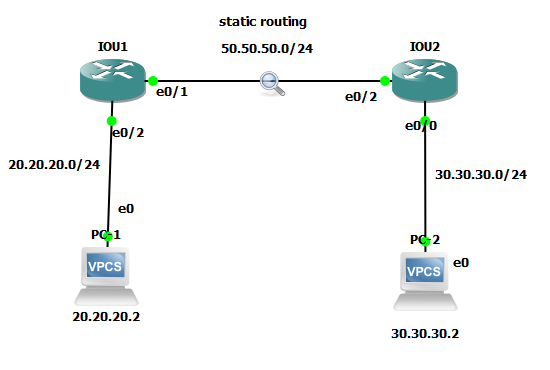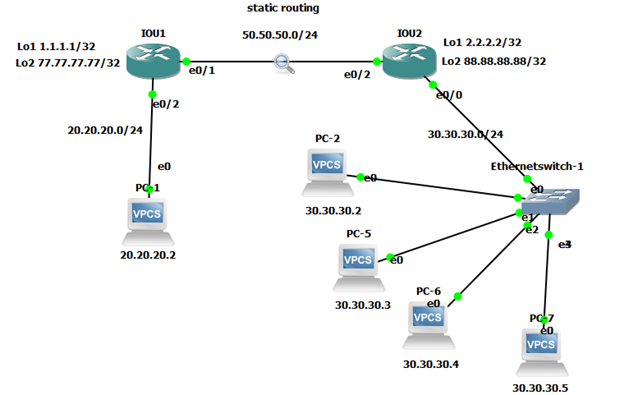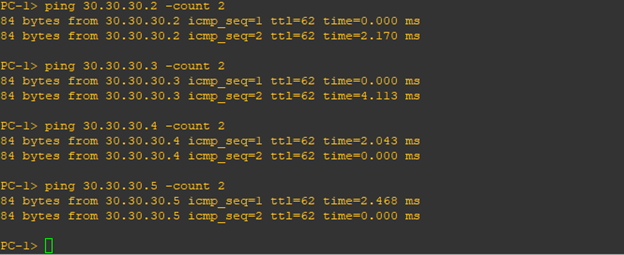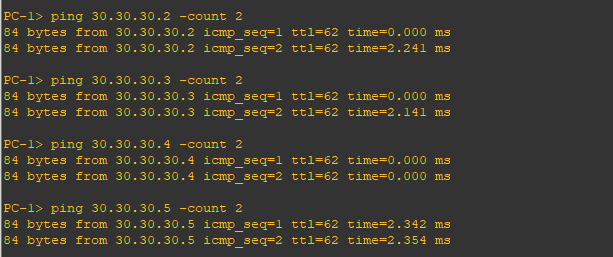
The IP assignment on interface is shown as above.
We will demonstrate the following case study.
Case Study 1: Static routes using exit interface
Case Study 2:Static routes using IP as next hop
Case Study 3:Static routes using exit interface and IP add as next hop
Let’s understand how the communication takes place in Ethernet or multi-access networks.
- Whenever router want to reach a particular destination, it basically needs two information viz the destination IP address where it wants to go and the L2 address with respect to the destination.
- The router must check first whether the outgoing interface is point to point or ethernet/multi-access. In case it is Ethernet then it must resolve L2 address
- For getting the L2 address the router must generated ARP request for the destination subset. The router must know on which outgoing interface it needs to generate ARP so the router do routing recursive process to know the outgoing interface for a particular destination.
Case Study I – Static route using interface as next hop.
On IOU1 lets configure static routes to reach network 30.30.30.0 pointing towards the next hop if IOU1 router.
Ip route 30.30.30.0 255.255.255.0 e0/1
Configure static routes to reach 20.20.20.0 network on IOU2 pointing towards its next hop as interface e0/2
Ip route 20.20.20.0 255.255.255.0 2 e0/2
When we point static routes with only interface as next hop then router assumes that the destination is directly connected in its local subnets.
This can be seen on IOU1

In this scenario router IOU1 already know the outgoing interface as we configured the ip route specifying the outgoing interface. So here IOU1 wil check the routing table and will get the outgoing interface detail in single lookup.
Since the network is Ethernet, the IOU1 must know the L2 address, so it will construct ARP packet having source IP address of PC1 and destination of 30.30.30.2. Source mac of IOU e0/1 interface and DMAC as 0.0.0.0.
When IOU2 receive the arp request packet to its e0/2 interface it will check its routing table if it knows about the destination. As per IOU2 30.30.30.0 network is directly connected to IOU2 e0/0 interface.

So IOU2 already know the network 30.30.30.0, it will reply the ARP packet generated by IOU1 with the detail of source ip as 30.30.30.2 destination ip 20.20.20.2 and SMAC as mac of IOU2 e0/2 interface and DMAC as e0/1 interface of IOU1.
Here IOU2 has sent its own interface e0/2 mac address detail to IOU1 instead of destination 30.30.30.2 host mac address. This is called as proxy arp.
So basically, what is the drawback if we only put next hop as interface. If we put next hop as an interface in point to point network it is not the issue, issue may arise when we have multi-access network(ethernet) like ARP overwhelms or say excessive arp generation.
Let’s ping 30.30.30.2 from PC1

As soon as PC1 ping 30.30.30.2 the request will come to IOU1 and IOU1 will try to resolve the L2 address for host 30.30.30.2.
Since as per routing table network 30.30.30.0 is directly connected to IOU1 int e0/1 , it will construct ARP packet and send it on int e0/1 that you can see in Fig 5 Wishark_IOU e0/1
Here source IP in arp is 50.50.50.1(IOU e0/1 IP) , destination IP is 30.30.30.2, SMAC is IOU1’s E0/1 mac and destination mac is 0.0.0.0
Fig 1 Wireshark_IOU1 e0/1

In this scenario we won’t feel excessive arp issue as we have only one destination network host i.e 30.30.30.2 pointing towards the nexthop interface e0/1 on IOU1.
Fig IOU1 ARP1

Now Imagine what will happen if a new request come for 30.30.30.3, 30.30.30.4 & so on. For all destination host one arp mapping will be generated. Since IOU1 does not know about next hop ip address so for every destination host it will broadcast.
Let’s add some more host on IOU2 and then we will ping each host from PC1 and then check the ARP table on IOU1.
Fig 11 More_host

Let’s ping each destination host form PC1

Let’s check arp on IOU1 . For every Host we have individual arp entry. Imagine what will happen if we would have 254 host on destination segment. 254 arp entry would have created.
Even worst if the destination address belong to class A then their could be 2^24 host allocation.
And for each 2^24 host individual arp entry would have created. Thus for Ethernet network It is bad idea to put the next hop as interface only. As this will create excessive arp entry which will ultimately degrade the router performance.
Fig 12. IOU1 e0/1 ARP_Broadcast
![]()
![]()
![]()
![]()

Hence it proved , next hop as interface only will create excessive arp entry in ethernet network 🙂
Case Study 2: Static routes using IP as next hop
Remove static routes from IOU1 & IOU2 configured in case study 1 and configured new static route with next hop as ip only
On IOU1
No ip route 30.30.30.0 255.255.255.0 e0/1
Ip route 30.30.30.0 255.255.255.0 50.50.50.2
On IOU2
No ip route 20.20.20.0 255.255.255.0 e0/2
Ip route 20.20.20.0 255.255.255.0 50.50.50.1
As per IOU1 routing table 30.30.30.0 is not directly connected and to reach 30.30.30.0 it must go to next hop 50.50.50.2 which is IOU2 interface e0/2 ip address

Now here IOU1 need to perform two lookup, First it will check the next hop to reach 30.30.30.0.
Second it need to find out the outgoing interface which is e0/1 of IOU1
So IOU1 will check 30.30.30.0 and it will get the next-hop ip as 50.50.50.2.Then it will check the routing table for 50.50.50.2 , which shows it is directly connected on interface e0/1

Now IOU1 already know that it needs to perform ARP on interface e0/1 in order to get the L2 address of 50.50.50.2.
IOU1 will keep ready the L2 address for 50.50.50.2 in its arp table.

Let’s ping all destination host from PC1 and then we will check the arp table on IOU1

Let’s check IOU1 arp table. As depicted as below we can see we have only one ARP entry for all destination host.

This is because the IOU1 exactly know the next hop address to reach the destination 30.30.30.0 so it handover all destination request to next hop ip address for which it already created L2 entry.
Hence it proved , next hop as ip address only won’t create excessive arp entry in ethernet network 🙂
Case Study 3 – Static route using exit interface and ip address as next hop.
Remove the configured static routes in case study 2 form IOU1 & IOU2 and configured new static routes with next hop interface and ip address combination.
On IOU1
No ip route 30.30.30.0 255.255.255.0 50.50.50.2
Ip route 30.30.30.0 255.255.255.0 e0/1 50.50.50.2
On IOU2
No ip route 20.20.20.0 255.255.255.0 50.50.50.1
Ip route 20.20.20.0 255.255.255.0 50.50.50.1
This is most efficient option among all other as we are providing all the detail to router in hand and it do not need to do routing lookup further to find the outgoing interface. Also when we specify interface with next hop ip address , then the ip route is automatically removed from the routing table in case the exit interface is down even though the next hop ip is reachable via some other alternate path.
Summary:
- Static option with only exit interface, will create excessive ARP on Ethernet network.
- Static option with only next hop ip address , will not create excessive ARP , but it need two routing lookup.
- Static option with exit interface and exit interface will not create excessive ARP , need single routing lookup and perhaps the best option to adopt.
